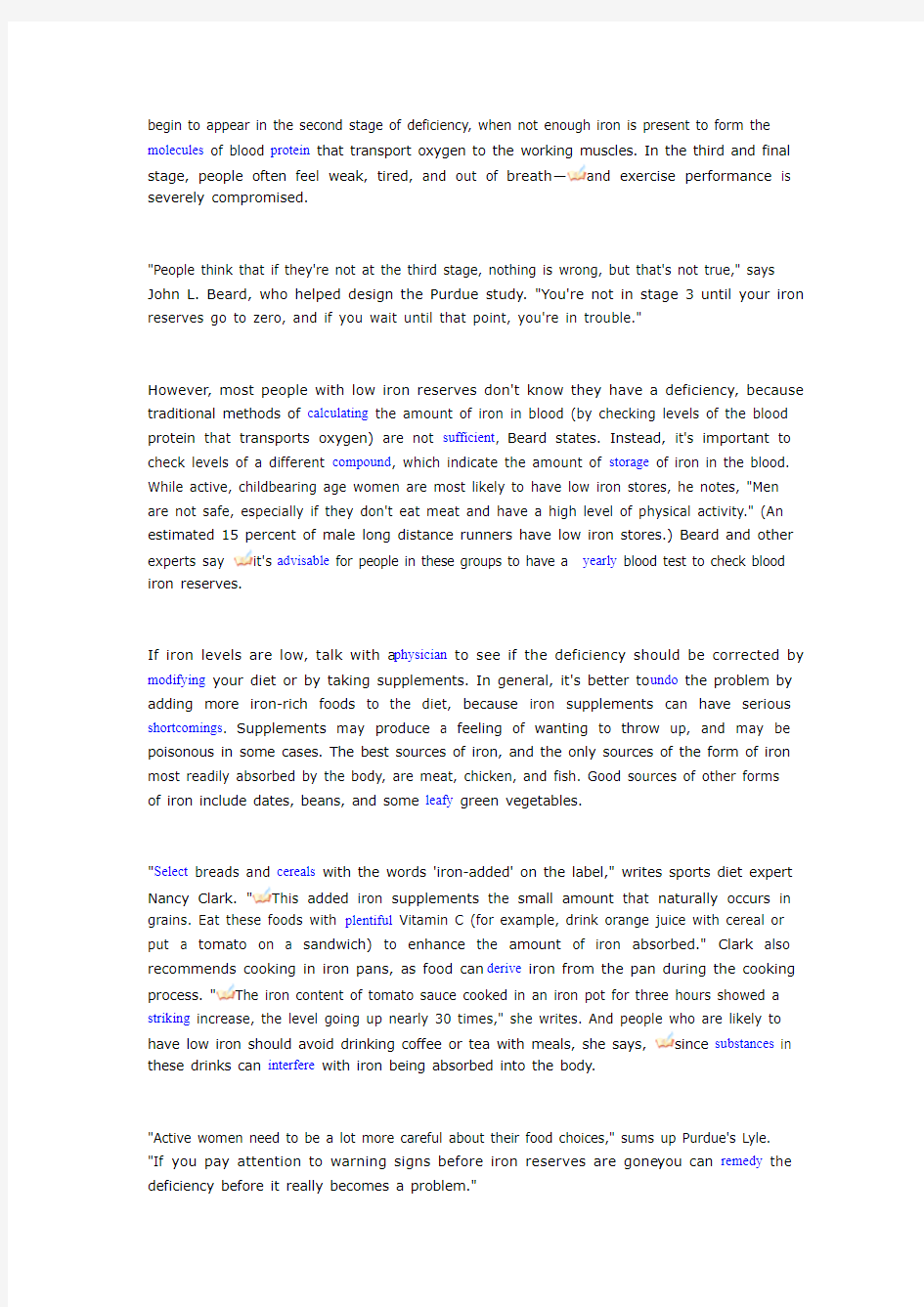

Unit2
Iron and the Effects of Exercise
Sports medicine experts have observed for years that endurance athletes, particularly females, frequently have iron deficiencies. Now a new study by a team of Purdue University researchers suggests that even moderate exercise may lead to reduced iron in the blood of women.
"We found that women who were normally inactive and then started a program of moderate exercise showed evidence of iron loss," says Roseanne M. Lyle, associate professor at Purdue. Her study of 62 formerly inactive women who began exercising three times a week for six months was published in the journal Medicine & Science in Sports & Exercise.
"Women who consumed additional meat or took iron supplements were able to bounce back," she notes. "But the new exercisers who followed their normal diet showed a decrease in iron levels."
Iron deficiency is very common among women in general, affecting one in four female teenagers and one in five women aged 18 to 45, respectively. But the ratio is even greater among active women, affecting up to 80 percent of female endurance athletes. This means,
Lyle says, that "too many women ignore the amount of iron they take in". Women of childbearing age are at greatest risk, since their monthly bleeding is a major source of iron loss. Plus, many health-conscious women increase their risk by rejecting red meat, which contains the most easily absorbed form of iron. And because women often restrict their diet in an effort to control weight, they may not consume enough iron-rich food, and are liable to experience a deficiency.
"The average woman takes in only two thirds of the recommended daily allowance of iron,"
notes another expert. "For a woman who already has a poor iron status, any additional iron loss from exercise may be enough to tip her over the edge into a more serious deficiency," notes the expert.
Exercise can result in iron loss through a variety of mechanisms. Some iron is lost in sweat, and, for unknown reasons, intense endurance exercise is sometimes associated with bleeding of the digestive system. Athletes in high-impact sports such as running may also lose iron through a phenomenon where small blood vessels in the feet leak blood.
There are three stages of iron deficiency. The first and most common is having low iron reserves, a condition that typically has no symptoms. Fatigue and poor performance may
begin to appear in the second stage of deficiency, when not enough iron is present to form the molecules of blood protein that transport oxygen to the working muscles. In the third and final
stage, people often feel weak, tired, and out of breath—and exercise performance is severely compromised.
"People think that if they're not at the third stage, nothing is wrong, but that's not true," says John L. Beard, who helped design the Purdue study. "You're not in stage 3 until your iron reserves go to zero, and if you wait until that point, you're in trouble."
However, most people with low iron reserves don't know they have a deficiency, because traditional methods of calculating the amount of iron in blood (by checking levels of the blood protein that transports oxygen) are not sufficient, Beard states. Instead, it's important to check levels of a different compound, which indicate the amount of storage of iron in the blood. While active, childbearing age women are most likely to have low iron stores, he notes, "Men are not safe, especially if they don't eat meat and have a high level of physical activity." (An estimated 15 percent of male long distance runners have low iron stores.) Beard and other
experts say it's advisable for people in these groups to have a yearly blood test to check blood iron reserves.
If iron levels are low, talk with a physician to see if the deficiency should be corrected by modifying your diet or by taking supplements. In general, it's better to undo the problem by adding more iron-rich foods to the diet, because iron supplements can have serious shortcomings. Supplements may produce a feeling of wanting to throw up, and may be poisonous in some cases. The best sources of iron, and the only sources of the form of iron most readily absorbed by the body, are meat, chicken, and fish. Good sources of other forms of iron include dates, beans, and some leafy green vegetables.
"Select breads and cereals with the words 'iron-added' on the label," writes sports diet expert
Nancy Clark. "This added iron supplements the small amount that naturally occurs in grains. Eat these foods with plentiful Vitamin C (for example, drink orange juice with cereal or put a tomato on a sandwich) to enhance the amount of iron absorbed." Clark also recommends cooking in iron pans, as food can derive iron from the pan during the cooking process. "The iron content of tomato sauce cooked in an iron pot for three hours showed a striking increase, the level going up nearly 30 times," she writes. And people who are likely to
have low iron should avoid drinking coffee or tea with meals, she says, since substances in these drinks can interfere with iron being absorbed into the body.
"Active women need to be a lot more careful about their food choices," sums up Purdue's Lyle. "If you pay attention to warning signs before iron reserves are gone, you can remedy the deficiency before it really becomes a problem."